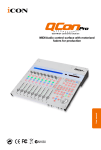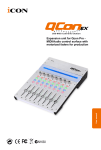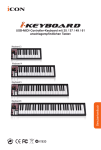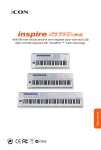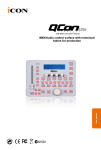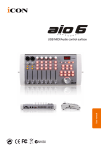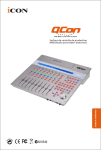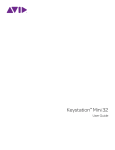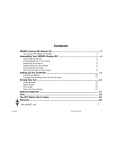Download User manual - Just Music
Transcript
25/37/49/61-note velocity-sensitive piano-style keys USB MIDI controller keyboard iKeyboard 3 iKeyboard 4 iKeyboard 5 User manual iKeyboard 6 Important Safety Instructions 1. Read this manual thoroughly before using this unit. 2. Keep this manual for future reference. 3. Take notice of and comply with all warnings included in the user's manual or indicated on the appliance. 4. Follow all instructions included in this manual. 5. Do not expose this unit to rain or moisture. Avoid having water or other liquids spilled on this unit. 6. When cleaning the cabinet or other parts of this appliance, use only a dry or slightly damp soft cloth. 7. Do not block any ventilation openings or interfere with the proper ventilation of this unit. Install in accordance with the manufacturer's instructions. 8. Do not use or store near any heat sources such as radiators, heat registers, stoves, or other heat- producing appliances. 9. Do not interfere with the safety purpose of the polarized or grounding-type plug. A polarized plug has two blades with one wider than the other. A grounding-type plug has two blades and a third grounding prong. These are designated for your safety. If the provided plug does not fit into your outlet, consult an electrician. 10. Protect the power cord from being walked on or otherwise damaged by items placed on or against them. Particular attention should be given to the plugs, receptacles, and the point where the cord exits the appliance. 11. To avoid the risk of electrical shock, do not touch any exposed wiring while the unit is in operation. 12. Only use attachments/accessories specified by the manufacturer. 13. Unplug this unit and all connected electrical equipment during lightning storms or when left unused a long period of time. 14. Refer all servicing to qualified service personnel. Servicing is required when the appliance has been damaged in any way or fails to operate normally. WARNING: To reduce the risk of fire or electric shock, do not expose this unit to rain or moisture Contents Introductions....................................................................................................................... 1 What’s in the package........................................................................................................ 1 Features............................................................................................................................. 2 Front panel layout............................................................................................................... 3 Rear panel layout............................................................................................................... 5 Getting started.................................................................................................................... 6 Connecting your iKeyboard controller................................................................................ 6 iMapTM software for Mac OS X............................................................................................ 6 Installing iMapTM software for Windows.............................................................................. 7 Assigning MIDI functions with iMapTM................................................................................. 9 iMapTM iKeyboard software panel....................................................................................... 9 Firmware upgrade............................................................................................................ 12 Restore the factory default settings.................................................................................. 12 Specifications................................................................................................................... 13 Velocity curve................................................................................................................... 14 Service.............................................................................................................................. 15 Introductions Thank you for purchasing the ICON iKeyboard USB MIDI controller keyboard. We sincerely trust this product will provide years of satisfactory service, but if anything is not to your complete satisfaction, we will endeavor to make things right. In these pages, you'll find a detailed description of the features of the iKeyboard, as well as a guided tour through its front and side panels, step-by-step instructions for its setup and use, and full specifications. You'll also find a warranty card enclosed - please don't forget to fill it out and mail it so that you can receive online technical support at: www.icon-global.com. And so we can send you updated information about these and other ICON products in the future. As with most electronic devices, we strongly recommend you retain the original packaging. In the unlikely event the product must be returned for servicing, the original packaging (or reasonable equivalent) is required. With proper care and adequate air circulation, your iKeyboard will operate without any trouble for many years. We recommend that you record your serial number in the space provided below for future reference. Please write your serial number here for future reference: Purchased at: Date of purchase: What’s in the package ●● iKeyboard 3 / iKeyboard 4 / iKeyboard 5 / iKeyboard 6 - 25/37/49/61-note velocity-sensitive piano-style keys USB MIDI controller keyboard x 1 ●● CD x 1 App software – iMap ( Mac & Windows ) User manual & QSG DAW software – Samplitude 11 silver ICON edition ●● Quick Start Guide x 1 ●● USB 2.0 cable x 1 1 Features owerful controller is equipped and easy setup with Mackie Control and HUI protocol. P Backlit LED touch fader reacts in real-time with DAW. Synchronize automatically with different channel value when switching between channels. ●● Dual function encoder knob (Enter & rotate) ●● 11-segment LED surrounding the encoder to indicate the rotating position. ●● Velocity-sensitive piano style keyboard ●● Modulation touchpad ●● Pitch touchpad ●● 3-segment LED screen ●● 18 assignable LED backlit buttons ●● Illuminated channel buttons including Rec-enable, Solo and Mute. ●● 6 illuminated transport buttons including Play, Stop, Rec, Rewind, Fast forward and Loop ●● Single Transpose button use combine with key switch to shift pitch effectively. ●● Octave up/down buttons ●● Multi velocity curves available for selection ●● Midi output jack ●● Expression & sustain pedal TRS connectors ●● Class-compliant with Windows XP, Vista (32-bit), Windows 7 (32-bit & 64-bit), and Mac OS X (IntelMac) ●● USB 2.0 high speed connectivity ●● Mackie control build-in for Cubase, Nuendo, Samplitude, Logic Pro and Abelton Live. ●● Mackie HUI protocol build-in for Pro Tool. TM ●● iMap software included for easy mapping of MIDI functions ●● Firmware upgrade available simply via USB connection and iMap software. ●● Robust metal casing with Kensington lock port ●● ●● 2 Front Panel Layout Note: Functions operate slightly differenently between DAWs. Please refer to your DAW manual for each function. The following description is based on the functions that operate in Apple Logic. 1. 25/37/49/61-note key switches 25/37/49/61-note velocity-sensitive piano-action key switches 2. Backlit LED touch fader to control DAW’s Channel/Master faders The touch fader could be used to adjust the parameter of different channels. Press the two “Track or Bank” shifting buttons to shift between channels. Also, by pressing the “Master” button, the fader will change to control the parameters of the master channel. 3. Dual function encoders The dual functioned encoder acting as a push-button and a rotary control. When an encoder is pressed, it may be used to change modes of operation or to change what appears in the display above the channel strips. When an encoder is rotated, depending on its assigned function, it can be used to adjust a channel’s pan, send level, or plug-in parameters. 4. Encoder LED The 11-LED surrounding the encoder lights up to indicate the relative position of the rotation without having to look at your computer. 5. Control buttons Recording channel control buttons section REC button - Activate and deactivate the recording state of the associated channel. The switch will light red when the channel is armed. SOLO button - Turn On and Off the solo state of the associated channel. The switch will light red when the channel solo state is on and other channels will be muted. You could solo multiple channel by pressing SOLO buttons on additional channels. MUTE button - Activate and deactivate the mute state of the associated channel. The switch will light red when the channel is muted. Master button - Switch the touch fader to control the DAW master fader. 3 Transport control buttons section PLAY button - Activate the play function of the DAW. STOP button - Activate the stop function of the DAW. REC button - Activate the record function of the DAW. REWIND button - Activate the rewind function of the DAW. FAST FORWARD button - Activate the fast forward function of the DAW. LOOP button - Activate the loop function of the DAW. Automation section READ button - Press the READ button to activate the read function of the current audio track. WRITE button - Press the WRITE button to activate the write function of the current audio track. Other control buttons Jog Wheel - Activate to use the encoder as a jog wheel. The jog wheel is used for various purposes specific to the DAW application, including shuttle and scrubbing functions. Program - Use together with the encoder to change the sound bank of your soft-synth. 6. Modulation touchpad Touchpad to adjust the modulation effect. It returns to default, “0” when released. 7. Pitch touchpad Touchpad to adjust the pitch bend. It returns to default, “0” when released. 8. Octave buttons Raise or lower the pitches played on your keyboard. 9. Transpose button Raise or lower the pitches (by less than an octave) played on your keyboard. Tip: While pressing and holding the “Transpose” button, press a keyswitch within an octave range from the original c1 position) to change the c1 to that particular switch. Note: Only the first could be changing the pitch if several zones are set. 10.Track </> buttons Track < Shift “one” channel up for all faders (except the master channel.) Track > Shift “one” channel down for all faders (except the master channel.) 11.Bank </> buttons Bank < Shift “eight” channels up for all faders (except the master channel). Bank > Shift “eight” channels down for all faders (except the master channel). 4 Rear panel layout 1. Expression Pedal Input A standard expression pedal can be connected via this 1/4” input. 2. Sustain Pedal Input This 1/4” jack can be used to connect a momentary footswitch, like a piano's sustain pedal. (ICON SPD-01) 3. Midi Out Port Use the MIDI Out terminal to connect an external synthesizer or sound module. 4. USB port Functions as a MIDI port to your notebook (or computer) and compatible software. Also provides power to your iKeyboard. 5. 12VDC/1A power adapter connector Connect your 12VDC/1A power adapter (optional) here. 6. Power switch Power switch for your iKeyboard. 5 Getting Started Connecting your iKeyboard controller 1. Connect the ikeyboard to your Mac/PC via the USB port. Choose a USB port on your Mac/PC and insert the wide (flat) end of the USB cable. Connect the cable’s small jack end to the iKeyboard. Your Mac/PC should automatically “see” the new hardware and notify you that it is ready to use. 2. Mode select & assign the MIDI messages to iKeyboard with iMap software. Select Mackie Control or HUI mode from the pull down menu for pre-mapped MIDI mapping. Select User Defined mode for self MIDI assignment. Refer to page.9 for “Assign the MIDI messages with “iMapTM” software. Tip: Make sure you have selected the correct DAW mode in the pull down menu 3. Setup your DAW Activate the ICON iKeyboard controller in your DAW or MIDI software using “MIDI Setup” or “MIDI Devices”. For LogicTM, CubaseTM and NuendoTM, choose Mackie Control at the “Device List”. Note: Every application does this a little different, so refer to your software user manual for the settings. iMap TM Software for Mac OS X Please follow the procedures below step-by-step to launch your iMapTM software to Mac OS X 1. Insert the Utility CD in your CD-Rom and double click “iKeyboard” Series iMap” icon. Diagram 1 Tips: By “drag and drop” the “iKeyboard” icon into the “Applications” folder, you could create a “iMap” shortcut on your Mac’s desktop. 6 Installing iMap TM Software for Windows Please follow the procedures below step-by-step to install your iMapTM software. 1. Turn on your PC. 2. Insert the Utility CD in your CD-Rom Diagram 2 After you have inserted the CD into your CD-Rom, an installation screen should appear as shown in diagram 2 ; click “Install”. Note : If the installation screen not appear automatically go to the CD folder and double click on “Setup” 3. Setup Wizard appear Diagram 3 Setup wizard appears, please click “Next” 4. Choose Install Location Diagram 4 7 Choose your preferred install location for iMapTM or use the default location and click “Next” 5. Select shortcut Diagram 5 Select the start menu folder in which you would like to create the iMapTM shortcut. Then click “Next”. 6. Create a shortcut on your desktop Diagram 6 7. iMap TM Please untick the box if you do not want to place a shortcut icon on your desktop for iMapTM, otherwise click “Next”. started to install Diagram7 The iMapTM installation has now started, wait for it to finish. Then click “Finish”. 8. Installation finished Diagram 8 Click “Finish” to complete the iMap TM software installation. 8 Assigning MIDI functions with iMap TM You can use iMapTM to easily assign the MIDI functions of your iKeyboard. Note: If your iKeyboard is not connected to your Mac/PC, the message “There are no MIDI input devices” will appear. Please connect iKeyboard to your Mac/PC with the provided USB cable. Diagram 9 iMap TM iKeyboard software panel iKeyboard’s iMap is divided into two main sections as described below: 1. Keyboard elements assignment These elements include the key switches, velocity curve, modulation/pitch bend touch pad, Sustain & Expression pedal, Transpose & Octave buttons. These elements are assigned by the top three drop down windows. To assign a control, select it by clicking it and assign a different midi message by the two drop down menus (MIDI Channel & CC). Diagram 10 1.1 1.2 1.3 1.1 MIDI Channel Assign MIDI channel from 0-16 1.2 CC value Assign MIDI CC value from 0-127. 1.3 Velocity Curve Select the available velocity curve of your keybed. For the difference velocity curve diagram, please refer to P.14 9 2. Control surface elements assignment These elements include all the buttons, the knob and the touch pad. These elements are assigned by the lower four drop down menus and the “Toggle/Momentary” button. Note: iKeyboard has built-in Mackie Control protocols & HUI for different DAW such as Cubase TM, Samplitude TM, Abelton Live TM, Logic Pro TM and ProToolTM By selecting the correct DAW and Mackie control (HUI) protocol, iKeyboard has automatically mapped the major functions and work seamlessly with that DAW. Diagram 11 2.3 2.1 2.2 2.1 Control Mode Mackie Control: Select “Mackie Control” for Mackie control protocol HUI: Select “HUI” for HUI control protocol User Defined: Set your own midi settings for all the controllers. Note: In “Mackie Control” mode, settings are fixed and not changeable 2.2 User defined mode (Advance user) If you would like to assign your own midi mapping, select “User Defined” mode at the control mode drop down menu. To assign a control, select it by clicking it and assign a different midi message by the three drop down menus. The table below shows the different types of midi messages and their changeable parameters. MIDI Message Type Channel Parameters Note 0 to 16 -1(C) to 9(G) CC 0 to 16 0 to 127 Program 0 to 16 0 to 127 2.3 Toggle/Momentary button Assignable to all the buttons for the control surface. Toggle – Midi message will be send and activate once Momentary – Midi message will stay active. 10 3. General setting to the keyboard Diagram 12 3.5 3.1 3.3 3.2 3.4 3.1 “Save file” button Click this button to save your current settings for the iKeyboard. The file is an “.ikeyboard” file. 3.2 “Load file” button Click this button to load a previously saved “. ikeyboard” setting file for your iKeyboard. 3.3 “Send Data” button Click this button to upload the iMapTM software settings to your iKeyboard via USB connection. Note: You must have connected your iKeyboard to your Mac/PC, otherwise the settings upload will not be successful. 3.4 “MIDI Devices” button Click this button, a MIDI device select window will appear as shown in diagram 13. Please select “ICON iKeyboard” for the MIDI Out Devices. Diagram 13 3.5 “Firmware Upgrade” button Click this button to enter into the firmware upgrade window for iKeyboard. Please refer to P.12 for the firmware upgrade procedure. 11 Firmware upgrade Step 1 Connect the ICON product using a USB connection. Press the “MIDI Device” button at the top to select your connected ICON product as the “MIDI In and Out” device at the pulldown menu. Note: If your connected ICON product model name does not appear on the pull-down menu, select “USB Audio” as the MIDI In and Out device. Step 2 Click the “Update” button. Step 3 Press the “MIDI Device” button at the top to select your connected ICON product as the “MIDI In and Out” device at the pull-down menu. Step 4 Click the “Open File” button to browse the new firmware file. Step 5 Click the “Download” button to upload the firmware. Warning : The firmware upload process “MUST” be completed and not be interrupted during the file uploading, otherwise the firmware may not be rewritten again. Restore the factory default settings To restore your iKeyboard settings to factory default, simply import the “Factory Default” setting file into your iKeyboard with the original setting of the iMap software. 12 Specifications Connector: USB Sustain & Expression MIDI I/O Power supply: Current consumption: Weight: iKeyboard 3 iKeyboard 4 iKeyboard 5 iKeyboard 6 Dimensions: iKeyboard 3 iKeyboard 4 iKeyboard 5 iKeyboard 6 13 USB connector (standard type) 2x1/4” TS connectors 5-pin Din connector 12V/100mA DC 100mA or less 2.135 kg (lb) 2.99 kg (lb) 3.837 kg (lb) 4.675 kg (lb) 479 (L) x 189 (W) x 68 (H)mm 18.86”(L) x 7.36”(W) x 2.68”(H) 644 (L) x 189 (W) x 69 (H)mm 25.35”(L) x 7.44”(W) x 2.72”(H) 810 (L) x 189 (W) x 68 (H)mm 31.89”(L) x 7.44”(W) x 2.72”(H) 974 (L) x 189 (W) x 68 (H)mm 38.35”(L) x 7.44”(W) x 2.72”(H) Velocity curve 120 120 100 100 80 80 60 60 40 40 20 20 0 0 1 10 19 28 37 46 55 64 73 82 91 100 109 118 120 120 100 100 80 80 60 60 40 40 20 20 0 1 10 19 28 37 46 55 64 73 82 91 100 109 118 1 10 19 28 37 46 55 64 73 82 91 100 109 118 0 1 10 19 28 37 46 55 64 73 82 91 100 109 118 14 Service If your iKeyboard needs servicing, follow these instructions. 1. Ensure the problem is not related to operation error or external system devices. 2. Keep this owner's manual. We don't need it to repair the unit. 3. Pack the unit in its original packaging including end card and box. This is very important. If you have lost the packaging, please make sure you have packed the unit properly. ICON is not responsible for any damage that occurs due to non-factory packing. 4. Ship to the ICON tech support center or the local return authorization. U.S. OFFICE: Icon Digital Corporation 8001 Terrace Ave., Suite 201 Middleton, WI, 53562 USA ASIA OFFICE: ICON (Asia) Corp. Unit 807-810, 8/F., Sunley Centre, No. 9 Wing Yin Street, Kwai Chung, NT., Hong Kong. 5. For additional update information please visit our website at: www.icon-global.com 15 www.icon-global.com [email protected]



















